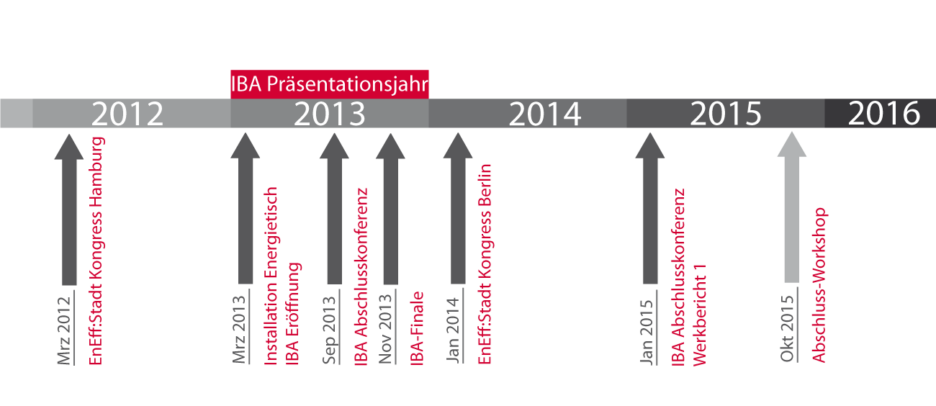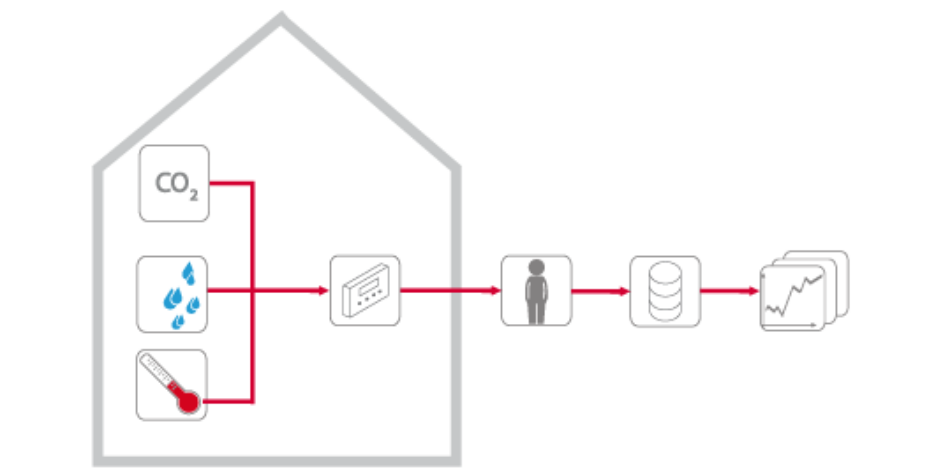IBA Hamburg
Back to project overviewProject description
Concept, quality assurance and scientific measurement program for the energy monitoring of the International Building Exhibition (IBA) Hamburg 2013.
Cover picture
The IBA Hamburg's field of action is the Elbe island between Norderelbe and Süderelbe in the Wilhelmsburg district. The aim is to realize a sustainable energy concept for the urban area.
The energy production and energy consumption of the entire area and the individual projects will be monitored and analyzed as part of the accompanying research, and the key data will be determined and documented.
As part of the International Building Exhibition (IBA) in Hamburg, the Institute for Building and Solar Technology (IGS) is conducting a research project on the topic of energy-efficient cities (EnEff:Stadt). The field of action of the IBA-Hamburg is the Elbe island between Norderelbe and Süderelbe in the Wilhelmsburg district. A sustainable energy concept for the urban area is to be implemented here.
Initially, the energy requirements and consumption of the area will be scientifically recorded and evaluated. The IGS is examining the energy balances for the district in more than 45 buildings in the form of monitoring concepts of varying depth. Energy consumption is evaluated on the basis of anonymized data from individual households.
Objectives
In addition to innovative energy concepts for individual buildings and systems, various strategies are being pursued to enable sustainable innovations.
The challenge lies in recording and visualizing the energy data of the individual measures and transferring them to the neighbourhood.
This data is presented to the public on the media table in the IBA dock.
Objective
The aim is an integrated concept in which data from different sources is processed and made available in a uniform monitoring system. All energy-relevant data is prepared in a uniform manner. The presentation ranges from the official IBA Hamburg website to a multi-touch model, information points and buildings to individual information for the residents of Wilhelmsburg.
Implementation
In addition to innovative energy concepts for individual buildings and facilities, various strategies are being pursued to enable sustainable innovations. The challenge lies in recording and visualizing the energy data of the individual measures and transferring them to the district.
The research project will be realized in three project phases:
In project phase 1, the ongoing conceptual process for the IBA and its individual projects will be standardized. The objectives with regard to energy efficiency and the methodological basis for implementation and evaluation are defined.
Project phase 2 comprises the monitoring and documentation of the construction measures as well as their commissioning and operational optimization. The focus here is on outstanding projects with particularly high multiplication potential.
In project phase 3, individual projects will be monitored, analyzed and documented in a uniform monitoring system and the energy balance of the IBA site will be updated, analyzed and evaluated in coordination with the preliminary studies.
An intelligent energy network and integrated supply and disposal concepts will be implemented and validated in operation. The projects complement and support each other in terms of content with the aim of exploiting the synergies of their results.
Timetable and milestones
timetable and milestones
- IBA Hamburg GmbH www.IBA-Hamburg.de Clausthal University of Technology, Energy Research Center of Lower Saxony www.efzn.de/ HafenCity University Hamburg - HCU www.HCU-Hamburg.de/ Cooperation partner external Synavision GmbH Achen
IGS work packages
Energy monitoring
The aim of building monitoring is to check compliance with the specified milestones for the emission-neutral supply of the Neues Wilhelmsburg residential district. Monthly and annual energy balances for heat and electricity are drawn up on the basis of measured consumption data in order to document the status of the buildings and the neighborhood.
For energy monitoring purposes, the IBA projects are divided into different categories. The scope of observation differentiates between two levels of detail. The simplified low-level monitoring covers heat and electricity with an annual resolution. Selected, innovative and pioneering buildings are examined in greater depth in extended high-level monitoring. In consultation with the project partners, exemplary individual projects are selected for this extended building monitoring, and the relevant emissions (CO2) of the buildings are calculated and presented in addition to the pure consumption data. For this purpose, data on energy consumption, energy procurement and local energy generation are recorded for all projects examined.
The measurement concepts of all buildings are structured in a comparable way and record at least the following values:
Total electricity consumption
Electricity consumption from the public grid
Decentralized electricity generation differentiated by type of generation (photovoltaic, CHP, etc.)
Total heat consumption
Heat purchased from (local) heating network
Heat provision differentiated by type of generation (solar thermal, CHP, gas boiler, biomass boiler, etc.)
Final energy consumption for the generation of electricity/heat differentiated by energy source (gas, biogas, wood pellets, etc.)
Comfort monitoring
In selected buildings - from the high-level monitoring - comfort is also measured in order to be able to evaluate the comfort in the highly efficient buildings. The results are correlated with user surveys.
In the following buildings, comfort is evaluated by measurement:
Gateway to the world (educational building)
Smart is green (residential building)
IBA Dock (office and exhibition building)
Open House (residential building)
Scheme for comfort monitoring
Scheme for comfort monitoring
As can be seen from the diagram, the indoor air temperature, indoor humidity and CO2 concentration are measured for comfort monitoring. However, recording does not take place over the entire duration of the project, but individually for each project over a period of at least two months. At least one cooling and heating period is measured. The data is recorded with a resolution of 15 minutes. The measurement results are fed back to the residents and users of the buildings.
Work packages Project partners
Coordination and public relations
IBA GmbH ensures cooperation between the individual projects and the research network.
IBA GmbH
Uli Hellweg, Heiner Baumgarten
Am Zollhafen 12, D-20539 Hamburg
Network monitoring
The EFZN and Clausthal University of Technology are responsible for system optimization, monitoring, plant technology and the overall system as well as balancing and evaluation at supplier and grid level.
The following projects are being investigated in grid monitoring:
Energy bunker: An old anti-aircraft bunker becomes a symbol of the "Renewable Wilhelmsburg" climate protection concept.
Georgswerder energy mountain: From a landfill hill to an energy mountain for 4000 households.
Wilhelmsburg Mitte energy network: individual "micro power plants" combine to form a large, "virtual" power plant.
Deep geothermal energy Wilhelmsburg: A geothermal power plant under the Elbe island.
EFZN - Energy Research Center of Lower Saxony
Energy systems and process energy technology
Prof. Dr.-Ing. Lars Kühl
Am Stollen 19, D-38640 Goslar
Clausthal University of Technology
Institute for Electrical Power Engineering and Energy Systems
Prof. Dr.-Ing. Hans-Peter Beck
Leibnizstraße 28, D-38678 Clausthal-Zellerfeld
User behavior, acceptance and satisfaction
HafenCity University (HCU) Hamburg is responsible for the analysis of the political, economic, social and media framework conditions and influencing factors, the evaluation of user behavior and user satisfaction and acceptance.
HafenCity University Hamburg
Urban planning and REAP
Prof. Irene Peters, Ph.D.
Überseeallee 16, D-20457 Hamburg
HafenCity University HamburgUrban and Regional Sociology
Prof. Dr. Ingrid Breckner
Überseeallee 16, D-20457 Hamburg


